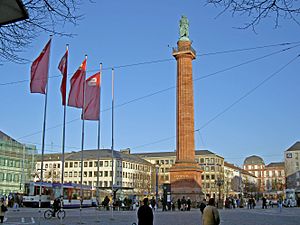Darmstadtium facts for kids
| Darmstadtium | ||||||||||||||||||||
|---|---|---|---|---|---|---|---|---|---|---|---|---|---|---|---|---|---|---|---|---|
| Pronunciation | ||||||||||||||||||||
| Mass number | 281 | |||||||||||||||||||
| Darmstadtium in the periodic table | ||||||||||||||||||||
|
||||||||||||||||||||
| Atomic number (Z) | 110 | |||||||||||||||||||
| Group | group 10 | |||||||||||||||||||
| Period | period 7 | |||||||||||||||||||
| Block | d | |||||||||||||||||||
| Electron configuration | [Rn] 5f14 6d8 7s2 (predicted) (predicted) | |||||||||||||||||||
| Electrons per shell | 2, 8, 18, 32, 32, 16, 2 (predicted) | |||||||||||||||||||
| Physical properties | ||||||||||||||||||||
| Phase at STP | solid (predicted) | |||||||||||||||||||
| Density (near r.t.) | 34.8 g/cm3 (predicted) | |||||||||||||||||||
| Atomic properties | ||||||||||||||||||||
| Oxidation states | (0), (+2), (+4), (+6), (+8) (predicted) | |||||||||||||||||||
| Ionization energies |
|
|||||||||||||||||||
| Atomic radius | empirical: 132 pm (predicted) | |||||||||||||||||||
| Covalent radius | 128 pm (estimated) | |||||||||||||||||||
| Other properties | ||||||||||||||||||||
| Natural occurrence | synthetic | |||||||||||||||||||
| Crystal structure | body-centered cubic (bcc)
(predicted) |
|||||||||||||||||||
| CAS Number | 54083-77-1 | |||||||||||||||||||
| History | ||||||||||||||||||||
| Naming | after Darmstadt, Germany, where it was discovered | |||||||||||||||||||
| Discovery | Gesellschaft für Schwerionenforschung (1994) | |||||||||||||||||||
| Main isotopes of darmstadtium | ||||||||||||||||||||
|
||||||||||||||||||||
Darmstadtium is a special kind of chemical element. Think of it like a building block of everything around us! It has the symbol Ds and its atomic number is 110. This number tells us how many protons are in its atoms. Darmstadtium is also known as a transuranium element, which means its atomic number is higher than uranium (which is 92).

This element is named after the German city of Darmstadt. Scientists first made it there.
Darmstadtium is a radioactive element. This means it gives off energy as it changes into other elements over time. You won't find darmstadtium in nature; scientists have to create it in a lab.
Scientists have made different types of darmstadtium, called isotopes. Some of these isotopes, like those with an atomic mass from 267 to 273, only last for a very short time. Their "half-life" (the time it takes for half of the atoms to decay) is measured in tiny fractions of a second.
However, two isotopes, Ds-279 and Ds-281, last a bit longer. Ds-279 has a half-life of 180 milliseconds, and Ds-281 can last for about 11.1 seconds.
Right now, we don't know what darmstadtium looks like. Scientists have only been able to make a few atoms at a time. This isn't enough to see it with our eyes or find any uses for it.
How Was Darmstadtium Discovered?
Darmstadtium was first made on November 9, 1994. This exciting discovery happened at a research center in Darmstadt, Germany. The center is called the Gesellschaft für Schwerionenforschung (GSI).
Scientists there made darmstadtium by crashing tiny particles together. They used a special machine to shoot nickel atoms at a piece of lead. When the nickel and lead atoms hit each other, they joined together. This process is called nuclear fusion. It created a brand new, heavier element: darmstadtium!
Here's a simple way to see what happened:
- 208
82Pb (Lead) + 62
28Ni (Nickel) → 269
110Ds (Darmstadtium) + 1
0n (Neutron)
The element was named after Darmstadt because that's where it was discovered. The GSI lab is in Wixhausen, a part of northern Darmstadt. The official name, darmstadtium, was given by a group called the IUPAC in August 2003. This group is in charge of naming new chemical elements.
| Periodic table | |||||||||||||||||||||||||||||||||||||||||
|---|---|---|---|---|---|---|---|---|---|---|---|---|---|---|---|---|---|---|---|---|---|---|---|---|---|---|---|---|---|---|---|---|---|---|---|---|---|---|---|---|---|
| H | He | ||||||||||||||||||||||||||||||||||||||||
| Li | Be | B | C | N | O | F | Ne | ||||||||||||||||||||||||||||||||||
| Na | Mg | Al | Si | P | S | Cl | Ar | ||||||||||||||||||||||||||||||||||
| K | Ca | Sc | Ti | V | Cr | Mn | Fe | Co | Ni | Cu | Zn | Ga | Ge | As | Se | Br | Kr | ||||||||||||||||||||||||
| Rb | Sr | Y | Zr | Nb | Mo | Tc | Ru | Rh | Pd | Ag | Cd | In | Sn | Sb | Te | I | Xe | ||||||||||||||||||||||||
| Cs | Ba | La | Ce | Pr | Nd | Pm | Sm | Eu | Gd | Tb | Dy | Ho | Er | Tm | Yb | Lu | Hf | Ta | W | Re | Os | Ir | Pt | Au | Hg | Tl | Pb | Bi | Po | At | Rn | ||||||||||
| Fr | Ra | Ac | Th | Pa | U | Np | Pu | Am | Cm | Bk | Cf | Es | Fm | Md | No | Lr | Rf | Db | Sg | Bh | Hs | Mt | Ds | Rg | Cn | Uut | Fl | Uup | Lv | Uus | Uuo | ||||||||||
|
|||||||||||||||||||||||||||||||||||||||||
See also
 In Spanish: Darmstatio para niños
In Spanish: Darmstatio para niños


